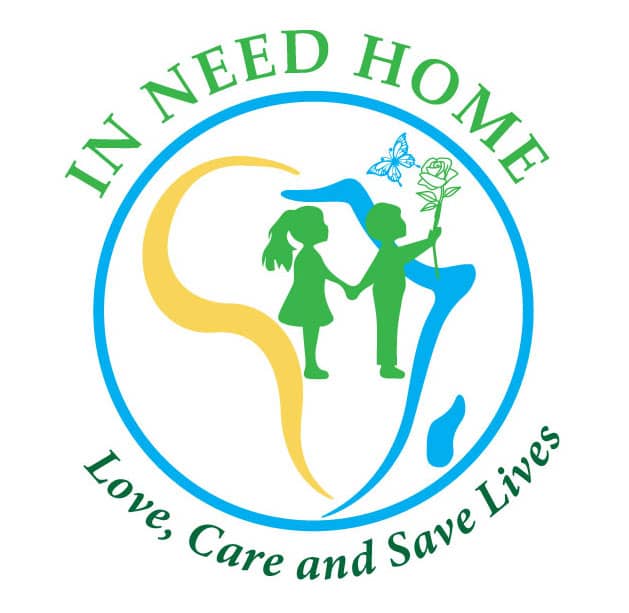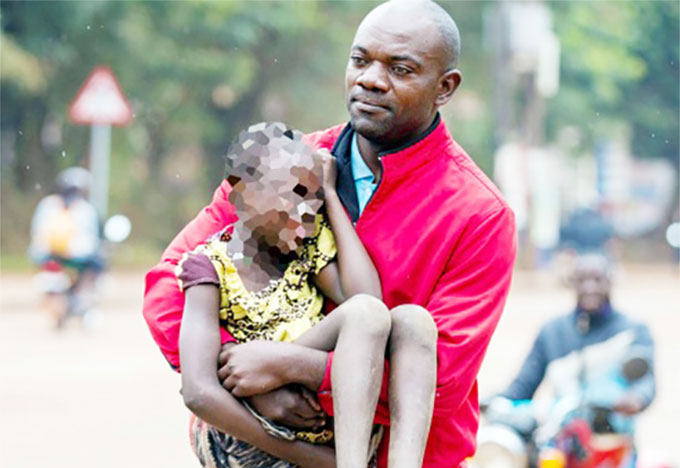
A KCCA law enforcement o cial with a rescued street beggars
At the busy Wandegeya four-way road intersection, it is common to find juvenile beggars in big numbers. Strikingly, nearly all of them hail from Karamoja and among them are some as young as two years old.
At any given opportunity, they knock on every vehicle caught in the traffic to beg for anything, right from money to any consumable. Even passersby and business owners are not spared from the begging. That has been the case until a recent swoop by KCCA to get the children off the streets.
But even in their best efforts, the city authorities are far from achieving their goal given that each day, fresh young beggars are brought to the streets through a syndicated network that also involves the children’s parents, writes GEOFREY SERUGO.
David Onyango, a fast-food restaurant operator in Wandegeya, has had enough of these child beggars but he seems helpless.
“We are caught between a rock and a hard place because these children have become a nuisance. Sometimes they hang around the restaurant and this puts off customers. But then, we have no option but to give them something to eat because they are clearly malnourished. The most unsettling bit is that we are helpless to do anything,” he said.
“Authorities have previously tried and failed to get them off the streets and we were left in a state of despair. These children don’t seem to be too many to remove but I suspect there is an organized crime gang behind.”
Indeed, early this month KCCA launched a full-scale operation through the city streets to remove the children and confront the child traffickers who to bring them to the street. In the course of the operation, KCCA officials rescued about 470 children and arrested 26 coordinators who bring them to beg on the streets.
On August 26, three of the suspects were convicted and sentenced to two months’ imprisonment by the City Hall magistrate’s court.
HOW SCHEME OPERATES
According to sources familiar with the trade, the traffickers meet all transport costs for these children from Karamoja. The children are then deployed to beg for money at the different junctions in Kampala. On any given day, the coordinators sit at designated spots and monitor the deployed children as they go about the begging.
The coordinators later pass by and collect money from the children and in turn remit someone money, ranging between Shs 5,000 and Shs 20,000, to the children’s parents in Karamoja.
According to the officials, the prevailing hunger crisis in the Karamoja sub-region has doubled the number of street children in Kampala over the past year. The hunger is linked to devastating consequences of the drought, the invasion of locusts, flash floods which led to poor harvests in the region, men’s attitude of abandoning their duties and over-depending on donors.
Currently, more than 500,000 people in Karamoja are going hungry and more than 200,000 children and lactating mothers are severely malnourished and are in need of urgent nutrition assistance. The hunger has claimed over 300 people in the sub-region.
SAFE HAVEN
Of the rescued children, 218 were taken to various rehabilitation centres which include Masulita children’s home for rehabilitation. The rehabilitation home was established by Uganda Women’s Effort to Save Orphans (Uweso).
Meanwhile, another 260 children off Kampala streets were transported to Koblin Youth Rehabilitation Centers in Napak district where they hail from.

In an interview with The Observer, Godwin Gumisiriza, the KCCA director for Gender, Production and Community Services, said there are more operations to rescue street children and designed strategies targeting perpetrators behind the crime.
“We are going to intensify the operations to have children taken to secure places. We are going to be arresting and prosecuting those involved in child trafficking and abuse,” he said.
Dorothy Kisaka, the KCCA executive director, said rescuing street kids from the streets and taking them to rehabilitation centres is not about maintaining a smart city but protecting children and their future. She applauded UWESO for opening up the Masulita home to take in the rescued street children, feed and rehabilitate them but noted that more homes are needed for those still on the streets.
“The law prevents you from giving handouts to children beggars. This is not bonafide begging. Behind every child beggar is an adult who is benefitting from the begging. We can’t condone this as a city. Let us dig out these criminals and child abusers together,” she said.
DISTURBING HIV REALITY
Sources who preferred anonymity intimated to The Observer that initially, the plan for KCCA was to take the children to Kampiringisa National Rehabilitation Center in Mpigi. However, they had a change of plan after getting unsettled by the discovery that a number of the children are already infected with HIV/Aids.
“It is a routine practice to check the health status of the children before they are put into a rehabilitation home but we were shocked to find a big number of the girls already infected,” said a source.
“We could not mix them with other children at Kampiringisa. These ones need specialized care and counselling.”
CHILD PROTECTION ORDINANCE 2022
In June, KCCA launched the Child Protection Ordinance 2022 to protect children from abuse forms like child labor and trafficking. The ordinance prohibits acts that encourage children to stay on the streets such as giving them food, money and clothing.
The law provides for imprisonment for six months or a fine of two currency points (Shs 40,000) for anyone who contravenes the law. The ordinance gives KCCA the responsibility to rescue children whose rights are being abused and begging on the streets.
It also provides that any child found begging or soliciting shall be rescued and committed to the custody and the care of the probation and social welfare office.
The ordinance provides for the prohibition of exploitation of children and related matters.
The ordinance was developed on the realization that children in Kampala were still facing several challenges, including exposure to harmful or hazardous employment, that include begging on the streets, vending food, bar and restaurant attendants, hawking general merchandise, employment as domestic servants, sale of harmful drugs, alcohol or any other intoxicating substance, to mention but anew.

